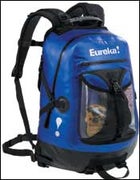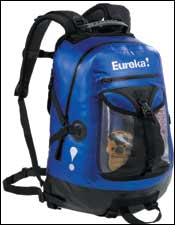One easy choice is to buy a roll-top drybag for your “regular” camera bag. Seattle Sports’ AquaCell Carbon Dry Bag ($30 for size small; www.seattlesportsco.com) has enough room for a camera bag and camera, and seals up very nicely.
 Storm Chaser
Storm Chaser
There’s also a small group of waterproof packs out there. SealLine’s Boundary Pack ($60 in the 65-liter size; www.seallinegear.com) is essentially a drybag with straps attached. Not a great load-carrier, but more than adequate for lugging camera gear on short portages. Again, I’d put my camera inside a traditional bagmaybe Lowepro’s holster-style Rezo TLZ 10 ($25; www.lowepro.com)then place that whole deal inside your drybag or drypack. That way you’re sure to have both padding and waterproofness.
Eureka! took a stab at making waterproof packs a few years back, and although they’ve discontinued the line, you can still find some examples. Do a search for Eureka! Storm Chaser Pack and you’ll find some for $70it’s basically a vinyl pack with sealed seams and a roll-top closure. It’ll shed rain, paddle splashes, and the like, and can withstand short immersion.
Lastly, consider a bear barrel, designed to keep bears from smelling or getting at your food. Sturdy and nearly 100 percent waterproof. The BearVault 250 ($67; www.bearvault.com) is a good candidate, with 430 cubic inches of space. Put the camera case inside, screw the lid shut, and you’re all set!
For the Web’s best selection of haulers, check out ���ϳԹ��� Online’s all-new .


